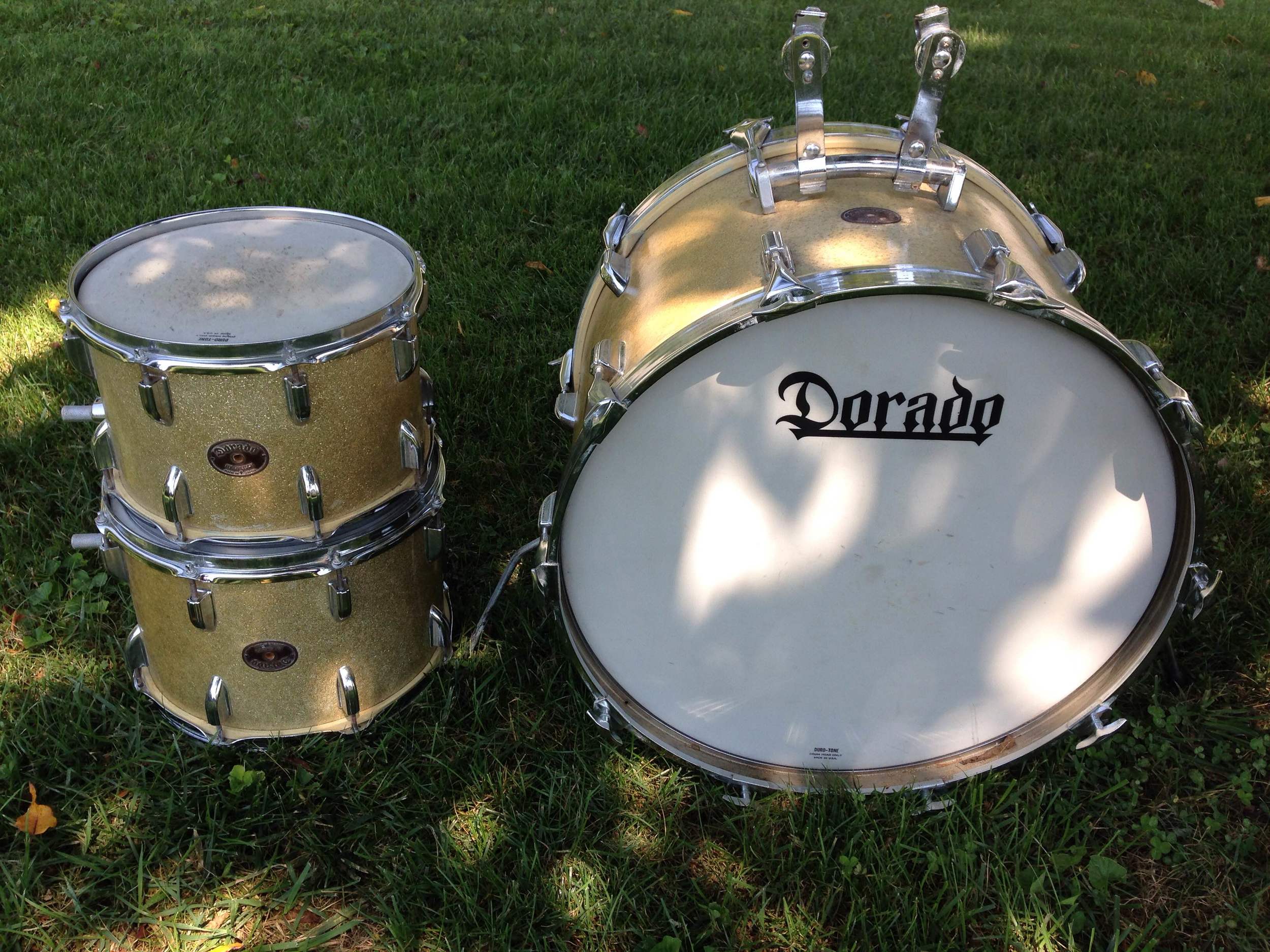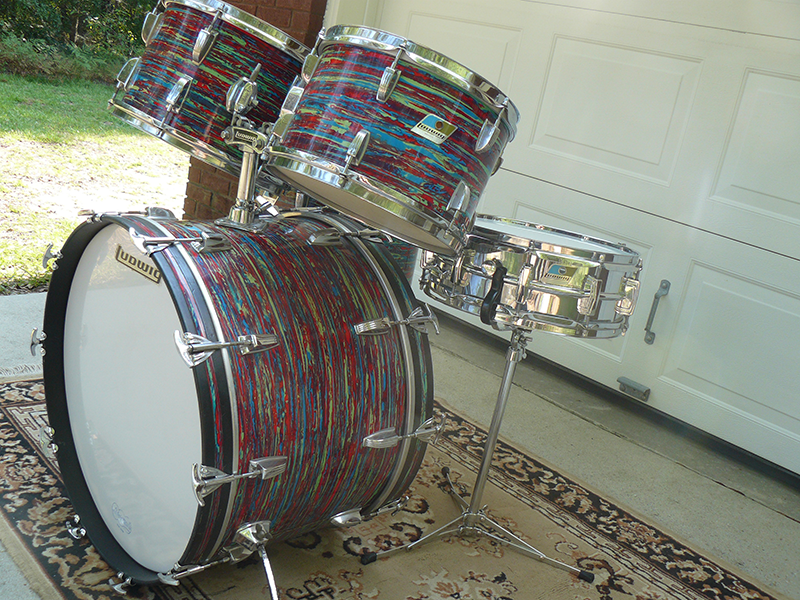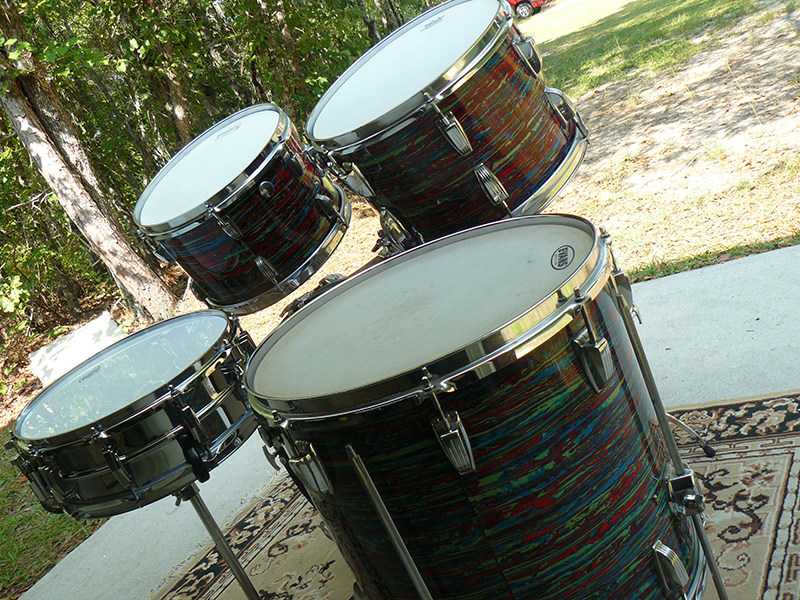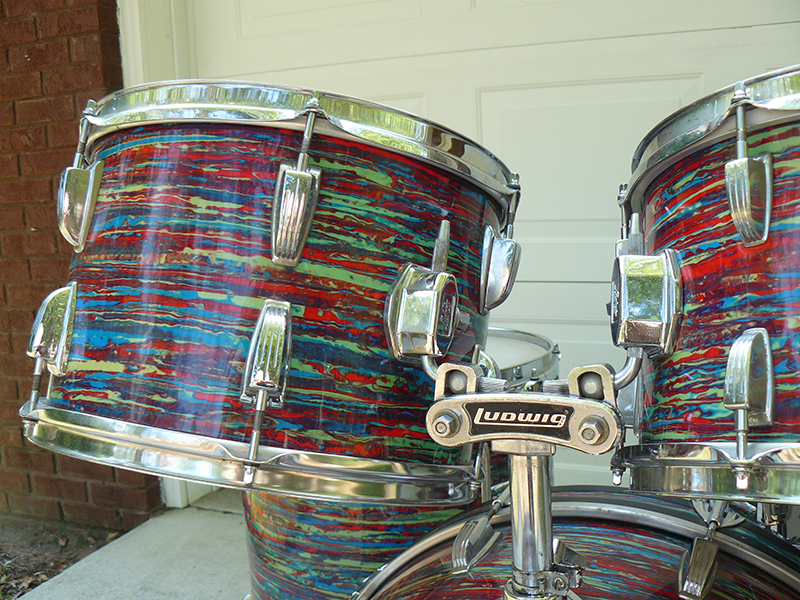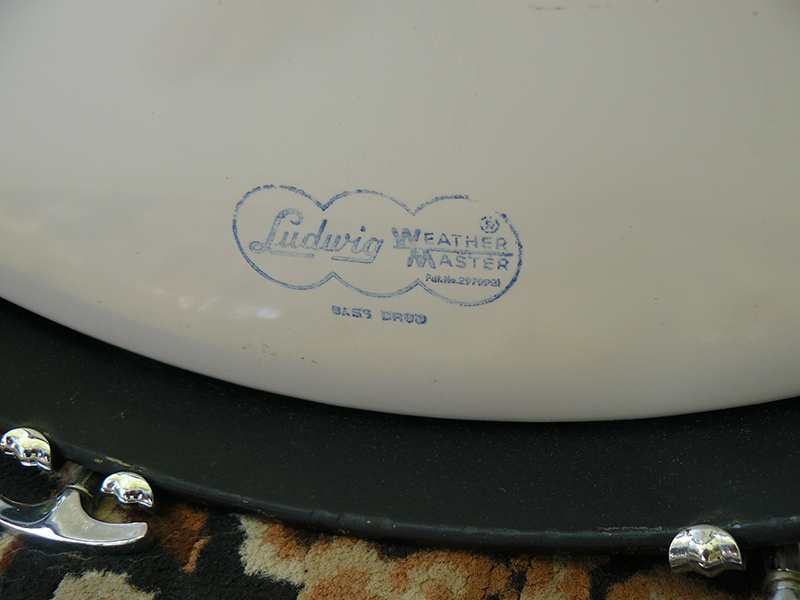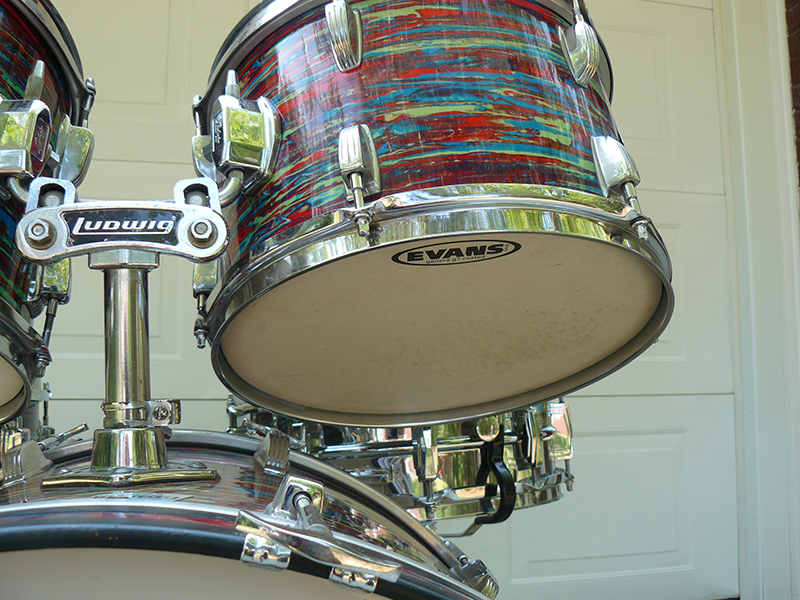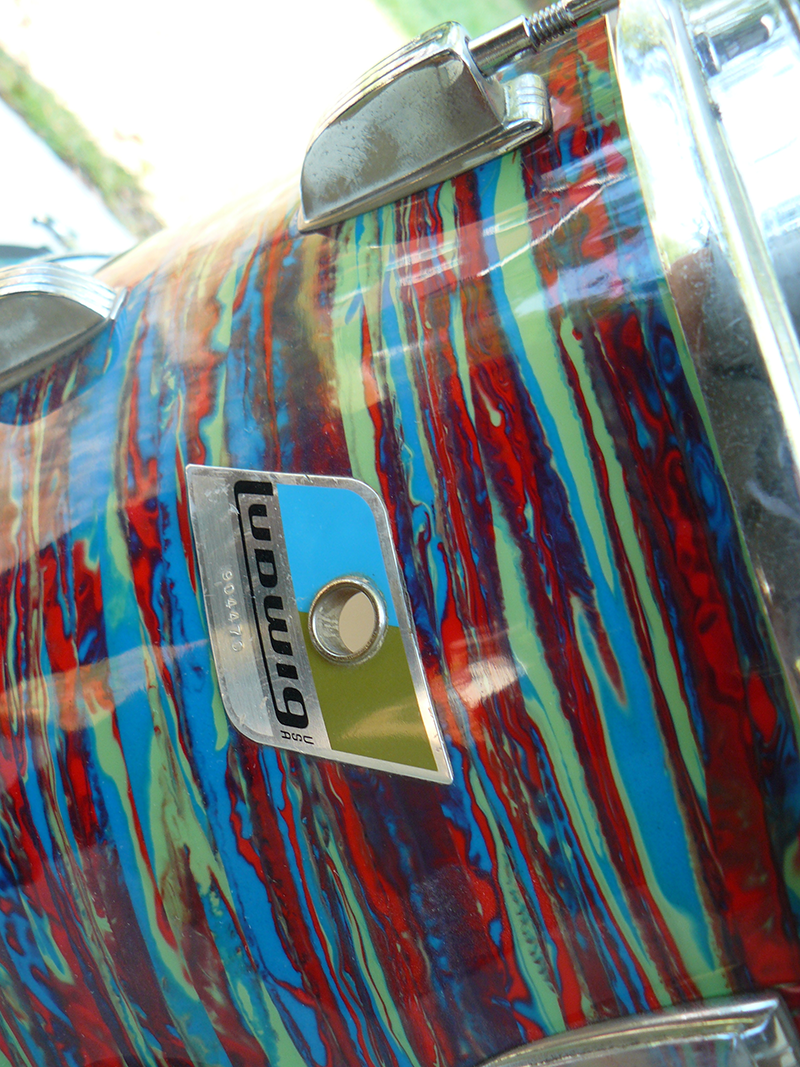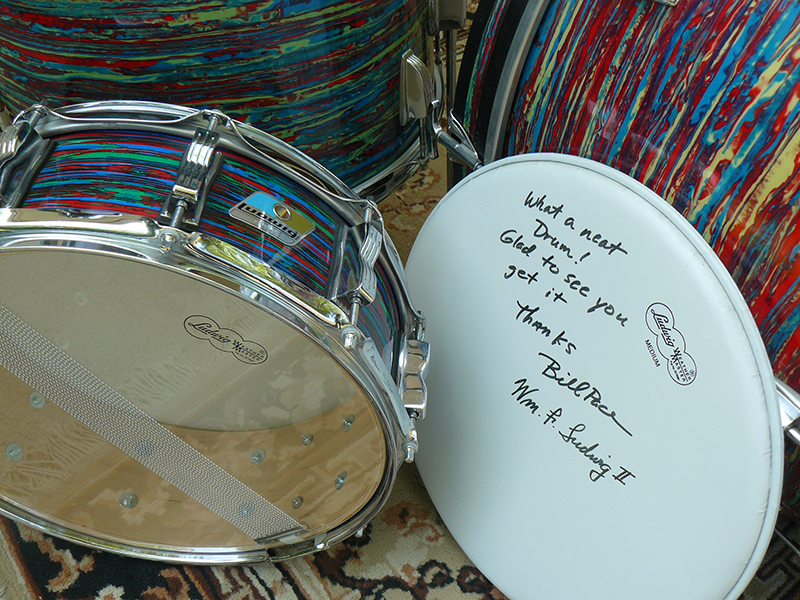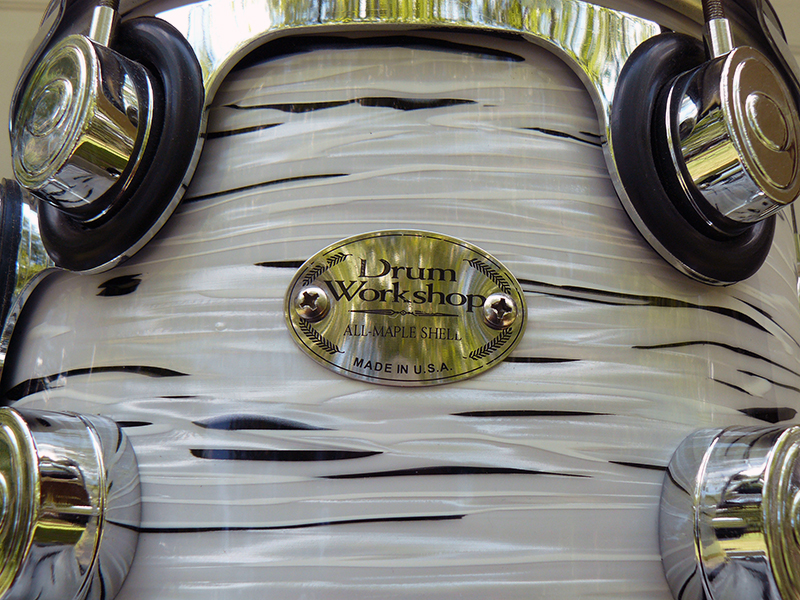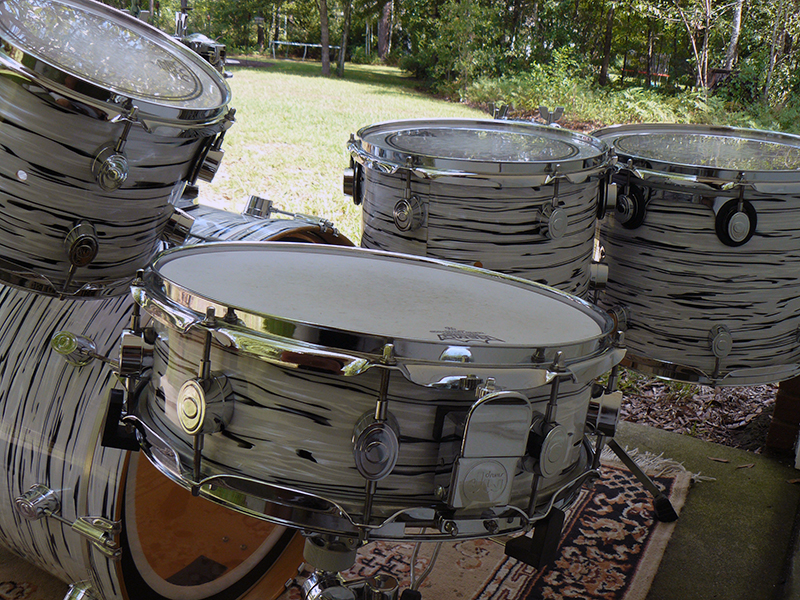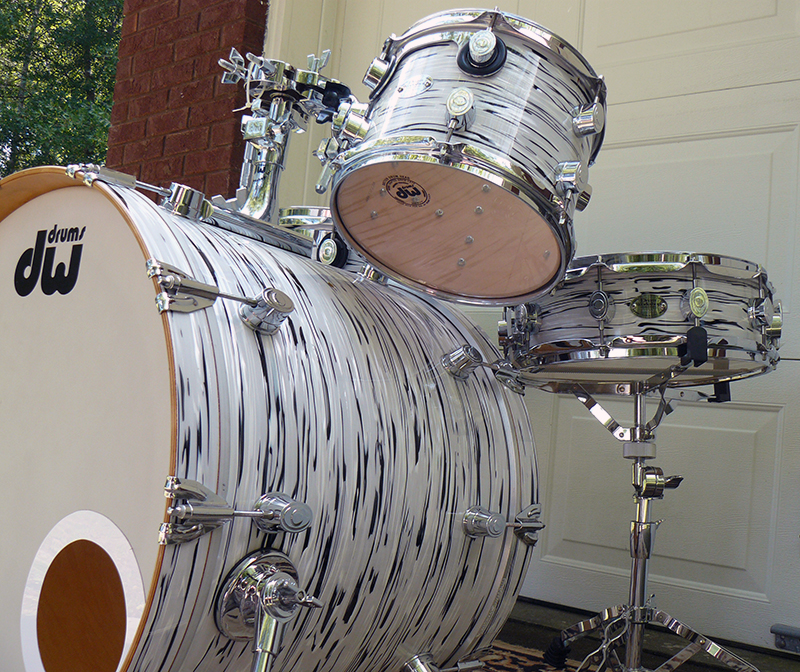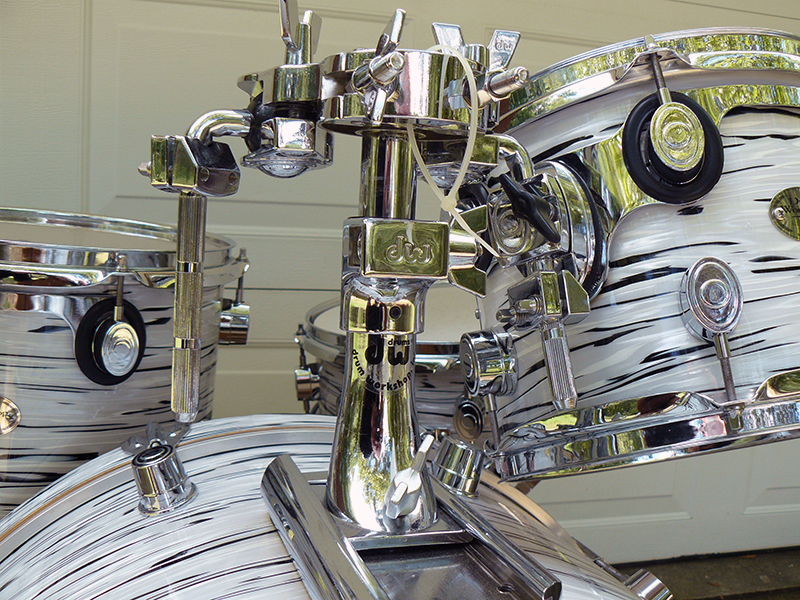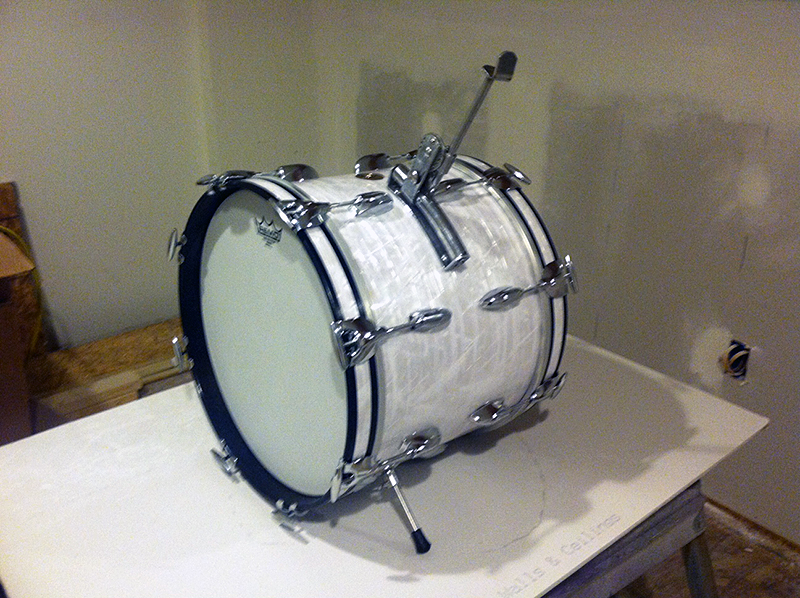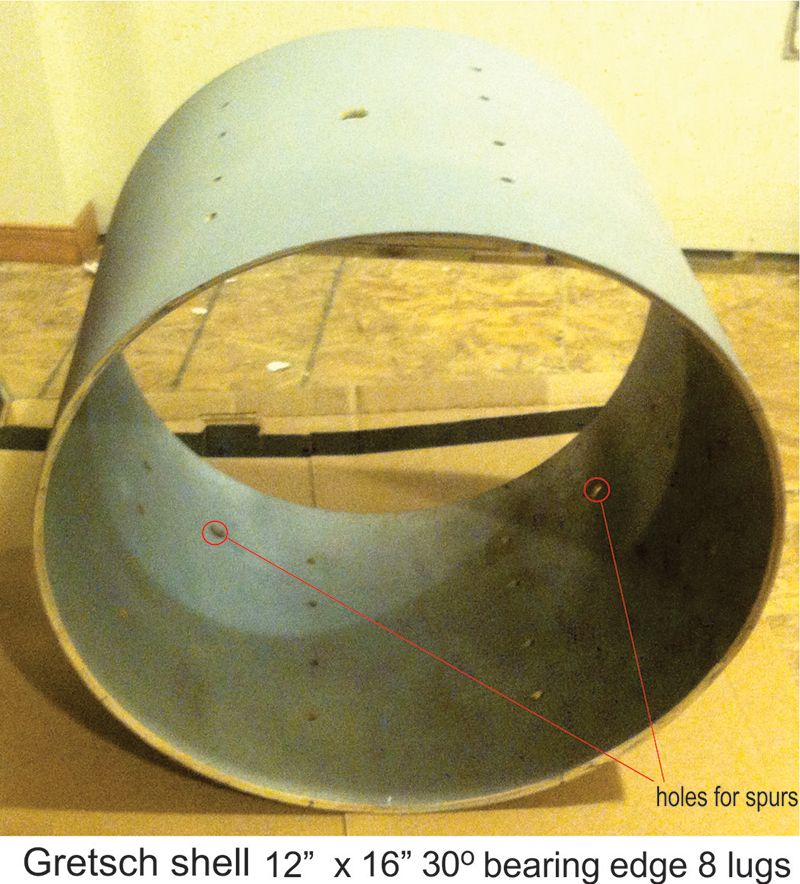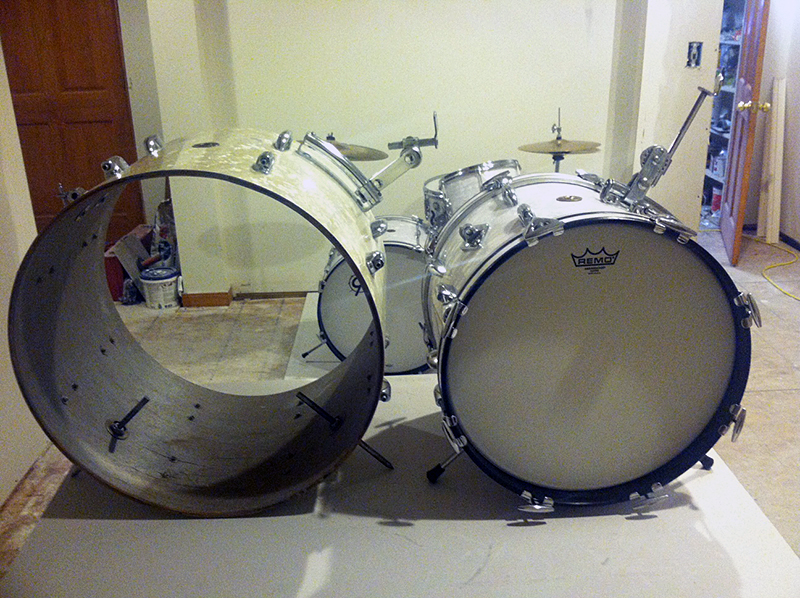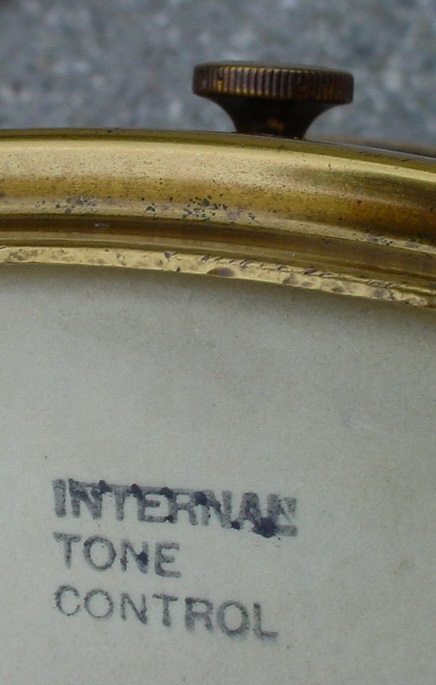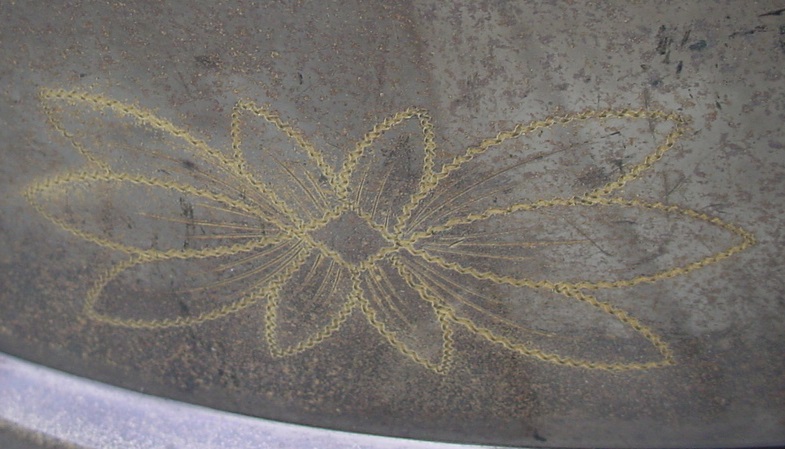In the end, I did not find a rare silver Stipelgold Ludwig snare drum. Indeed, what I received was an even rarer gift, a beautiful circa 1930 brass Ludwig drum that was passionately played by a war hero and kind friend to many.
Read moreWho had this pedal at the 2013 Chicago Drum Show?
Reader looking for this pedal that was at the Chicago Drum Show
Read moreDorado by Gretsch - Made in Japan
This was sent to me by my drum nerd buddy Jay in Knoxville TN. He is the administrator of the Facebook group "Knoxville Drummers Union". He goes by the code name Jay Options over there. I think he is hiding from someone. You have to know the secret password to join that group and they are a shifty bunch :-) . Dorado Drums were added to the Gretsch Dorado catalog in 1973. They were cheap Japanese stencil sets; imports and didn't hang around too long. That's about all I know about them. I would put that particular set of Jay's in the $200 category just because they are in good shape. If the floor tom and snare drum were there they might be worth $300 to $350 - George Lawrence
Here is a quote from author Mike Jones about Dorado guitars. Some of this may be applicable to Dorado Drums.
" I love the Dorado myself and have the same model 12 string as you. I also have 2- Model 5985 solid-body electrics. They are extremely well made and very playable. I am including information about them in a chapter of my book "Gretsch's Lost Weekend; The Guitars of Booneville and The Hagner Musical Instrument Company, 1970-1981" I am not going to be devoting much to the acoustic models but here's what I can tell you.
The Dorado guitars were made by Matsumoko of Japan between 1971 and 1973. The most intersting thing is, other than minor cosmetic differences, Matsumoko made the exact same guitar for Epiphone, Aria, Conrad, Granada and Lyle, though less so, their acoustic guitars. The ones that were marketed by the other companies were manufactured between 1970 and 1976. The Headstock design seem to be the only real variable on all of the models. As to why they were distributed by Gretsch, there was a long standing rumor that the Dorado was imported by Gretsch/Baldwin to make up for the lack of inventory after the Booneville factory fire in January 1973 destroyed the Gretsch production facility. While a plausable theory, It doesn't work with the time line. It appears to be more of a deal worked out by Fred Gretsch (still on the Gretsch/Baldwin Board of Directors) and Bill Hagner to work with Japanese suppliers. Gene Haugh told me that the decision to import was made in the spring of 1972 by Baldwin and Fred Gretsch. The first catalogs with Gretsch's name appeared in the fall of the same year and offered only acoustic models. In the 1973 catalog they offered an electric 6 string solid-body as well as a solid-body 4 string bass. Your 12 string model was one of two 12 string models offered in the 1973 catalog. Interstingly they also offered drums that year. A little known fact that you might enjoy. Gene told me that Fred brought a Dorado acoustic to Booneville one day in early 1972. According to Gene, Fred had put some masking tape over the logo, came into Gene's office and asked him to try it out. Gene played around with it for a few minutes then Fred asked him how he thought it played and what he thought it was. Gene said it played great and thought it was a Gibson. Fred peeled the tape off to expose the Dorado logo and said "That's what I thought too. Were gonna start distributing these." Gene told me he didn't care much for the electric solid body model's finish but the acoustics were as good as anything anyone was making during those days. Dorado had 3 logos. Plain Gold screen in fat block letters, Gold silk screen normal block letters in 1971-72 and in 1973 they introduced a Stylish in-laid mother of pearl logo. Yours is a 1973. I'll see if I can find some acoustic pics of the Aria, Epiphone, Conrad, Lyle acoustics so you can see they are all the same. For now, here's how the Dorado solid-body electric compares with all the other Matsumoko solid-body electric guitars. I hope this helps.
Mike Jones
Restoration Tips - Fixing Bent Rims
With wrench in hand and the aid of this article, you can remove unsightly bends and restore a rim to its original contour.
Read moreF. Baron snare drum, circa 1930s
F. BARON was a music store located in Paris, which existed in the 30/40 years. Very little information exists, but they created a brand "CONTINENTAL Paris New York", drums and snare drum which are so rare.
Read moreSeimatone Chromatic Snare Drum -@1948
with this snare, only two tuning knobs are necessary to adjust the tension, one by a head ! The internal chromatic system is very complex but works perfectly, and allows you to change tone while playing
Read moreJasper Wood - Gretsch's standard 6 ply shells and Centennial shells
The company Jasper Wood closed down in 2003. Because they had been primarily an office-furniture manufacturer they were forced out of business by the importation of cheap products… we’re all guilty here!
Read more1960s Ludwig Super Classic
This set of Ludwigs from my collection is covered in Sparkling Burgundy Pearl. This is one of the rarest sparkle finishes found on vintage drums today. Ludwig introduced this finish in 1967 having cancelled Galaxy Sparkle, the rarest of the Ludwig sparkle finishes.
Read moreJohn Bonham’s Vistalite B&W Candy Stripe Kit
John Bonham’s Ludwig Vistalite Black & White Candy Stripe swirl drum kit used during his time with Led Zeppelin was originally given to music critic Chris Welch by Bonzo himself. It is one of the only kits outside of the Bonham estate.
Read more@ 1927 Ludwig DeLuxe Genuine Gold Trimmed Model Snare
I was at a loss to find any of the previous owners prior to Bun E. I keep wondering who was the drummer who bought and played this drum almost 90 years ago. I wish I knew…
Read more1935 Ludwig & Ludwig 6.5 x 14 Gold Sparkle (Flash)/Classic Gold Standard Model
Here’s another snare drum fresh from the 2015 Chicago Vintage Drum Show and now in the “Bun E. Carlos wing” of the Curotto Collection. I got this one from Bun E. Carlos.
Read more1970s Ludwig Blue Big Beat Vistalites
This set I am featuring from my collection is a 1970s blue Big Beat set. The clear and blue colors have been Ludwig's best sellers through the years. I suppose Amber and yellow also sold well thanks to the Bonham influence.
Read more1920s Sonor Drums & Hardware
1969 Ludwig Psychedelic Red Hollywood Drum Set
It's really warming up for us here in the deep south. I hope your Summer has begun well. I got out early this morning to photograph this drum set for my article and I am still sweating all over the drums as I set them up. I know this set is not mint, but they are a good example of this attractive and desirable finish. I have been writing for the magazine for a while and the reason they keep me around, I guess, is because I am just a regular collector like most of you. I am not a super rich man with unlimited funds to spend on drums. Boy if I were rich I would go wild at the drum shows and keep E-Bay and UPS very happy. Instead, I save for a while and look until I find a kit or snare that really turns me on. I have bought a few pieces every year for the past twenty years, and sold a few pieces now and then. I have sought to improve the collection as I go along. I will buy a set in a finish I like, and when the set in the same finish in better condition comes along, I'll buy it and sell mine. I really don't consider myself a hoarder. I don't have five matching drums in the same finish or anything like that. If I have an extra drum in a finish another collector wants I share up.
The set I am featuring this month is a beautiful Ludwig Hollywood set from 1969. The wrap is Ludwig's exclusive Psychedelic Red Pearl finish. The big drum companies of that day mostly shared the sparkle colors and pearl finishes on their drums, but no other drum company dared to offer this finish, so it was only on the Ludwig sets. Ludwig tried two other psychedelic finishes on their drums, but they were not as successful in sales compared to this awesome finish. I don't have the time nor words to describe what psychedelic means to us who were from the sixties, but suffice it to say we loved everything psychedelic during that period of our lives. The wild colors are a part of that movement, and these drums are very colorful. Someone described this finish as looking like a "frog in a blender." The badges are the Blue Olive parallelograms that replaced the Keystone badges that year. The interiors are natural maple that has been clear coated. The sizes are typical for the Hollywood sets. Bass drum 22"X14", floor tom 16"X16", mounted toms 13"X9", and 12"X8". The snare is a 14"X5" chrome Supraphonic. This was the type snare that went out with most of the sets sold.
This was one of the earliest sets I bought when I started my collection. When I was in high school, a friend got a double bass drum set of Ludwigs in this finish. When I saw those brand new Psychedelic red drums I couldn't believe how spectacular they looked. I never got over that, so I went looking to recapture that experience by owning a set like those. I told my good friend Bill Pace, who actually had a vintage drum store at that time, to let me know if he found a set I could buy. He called me one afternoon with the news that he had a set in his store if I wanted to see them. I took my son with me to share the excitement. We bought them and I have certainly enjoyed owning them ever since. They are not perfect, as I said, but if you get a chance to buy a set like this in almost any condition you should do it. The finish fades with time and light exposure. The green color is the first to go. Even faded they are still desirable.
I don't know if this will make the editors cut or not, but I also included a picture of a Ludwig factory Psychedelic wood shell Supraphonic re-issue snare drum Ludwig made for me just before they re-issued the color on sets fifteen years ago. I along with others had requested Ludwig re-issue the finish, and so I got one of if not the first one. The head was signed by Bill Pace who sold me the original kit and by the "Chief" Mr. Bill Ludwig.
1947-50 METJAZZ Snare Drum
Here’s the latest snare drum to enter the collection. I got this drum from Emmanuel Giraudon who owns Oldrums in France (www.oldrums.fr).
Read moreHow To Date 1960s Ludwig Drums By Serial Numbers
Prompted by the insurance industry, the new regulation mandated serial numbers on certain goods, including drums. "Up until then," said Mr. Ludwig, "some of our drums were date stamped and some weren’t - but none had serial numbers. Our dealers begged us to put them on, so we had our badge manufacturer imprint sequential numbers on the badges for all of our drums."
Read moreDW Workshop Series
The Chicago Drum show in May was all I expected it to be. My only problem was I didn't have enough time to really dig in and see everything. My wife and I drove to our son and daughter-in-law's home in Charlotte on Friday. It was hard to sleep Friday night. I was extremely excited about going to the show on Saturday. My son and I started out early Saturday morning with a flight to Chicago. We rented a car and drove out to St. Charles to the fairgrounds where the show is held. I thought I would have plenty of time to see everything and visit with friends. There was so much to see and it was time to catch a plane back to Charlotte before I knew it. If I get to go back next year I will definitely plan to have more time. There were so many people there I wanted to talk to, and if I didn't get to speak to you, I'm sorry. I highly recommend that you go to a vintage drum show if you possibly can. Watch for announcements in the magazine for shows around the country.
The drum kit I want to feature this month is a beautiful set built by Drum Workshop. I know you are all familiar with the awesome drums this great drum company is making. The Collector Series is the flagship drums of Drum Workshop. They have the Aristocrat lugs like the ones made popular by George Way and Camco drums. Drum Workshop is built on the foundation of Way and Camco. The Workshop Series line of drums was the company's first attempt at a second line of drums. It was a set that was offered to the working and hobby drummer at a slightly better price, but still very high quality in every way. The most noticeable difference was the oval lugs instead of the round lugs. Another difference not so noticeable was the thin Keller shells without reinforcement rings. These drums sound fantastic. The first Workshop Series drums were limited in colors and sizes. That soon was scrapped because there were special orders for Workshop Series drums in special sizes and wraps. Drum Workshop officially only made the Workshops a couple of years, but continued to make them for special orders for quite some time.
The following information was gleaned from a drummer's forum. There was no name given, so I can't give proper credit. The facts are good and answers a lot of questions about these great drums.
BACKGROUND INFO ON THE DW WORKSHOP SERIES LINE:
"My drums are DW Workshop Series, made in the U.S. in 2000. There is much confusion surrounding this somewhat-rare line offered by DW.
I have read a lot of messages of people inquiring about DW Workshop series drums with most replies having bits and pieces of truth with some personal opinions thrown in. Lots of readers want to know about their quality and their price range. The Workshop series for the record were indeed 100% DW drums. They were manufactured in the USA (Oxnard), contrary to what some people have been stating. They were never made in Ensenada, Mexico. They were manufactured with what resembles the PDP lug to distinguish them from the Collector series.
They were built for only two years. They were made without reinforcement hoops, and were meant to be DW's good, mid-range product. Since they were just as expensive to manufacture as DW's Collector's Series, they were discontinued. Apart from that, they were favored by many DW endorsers in spite of the Collector's series.
They were DW's first go at manufacturing an American made "mass produced" set. They didn't offer the custom features like timbre matching and had limited finishes. The finishes were a high-gloss lacquered all-maple shell, or a Satin-Oil all-maple shell. The drums, aside from the different lugs, garnished authentic DW hardware as in the snare strainer. bass drum spurs and tom mounts. Again, 100% DW. DW dropped this line after about 2 years in production because they became too costly to produce, rivaling the production costs of their collector series, but they didn't carry the same retail price tag.
So with that, the line was scrapped in favor of the Pacific line. With the technology they gained making the Workshop series, they started to produce the PDP's in Taiwan. Pacific’s were not originally manufactured in Ensenada. DW chose to move the PDP line to Ensenada in the mid 90's to keep the costs down on the shipping tariffs from overseas and to be closer to the factory for quality control. But to state it one more time, the Workshop series was an American manufactured all-maple set. The sound is impeccable and they do not have the reinforcement ring for a broader sound, something DW is now offering (priced) on their Collector series sets. All the Workshop series drums have a DW badge with a serial number stamped on each shell stating "Made in the USA."
The Bottom Line Facts: These drums were "Made in the USA", with the same quality maple and parts that go into the Collector's Series drums. The only difference- apart from the differently-shaped lug housings, is that these have no reinforcement hoops. This difference is said to give them more sustain and a more open tone. I completely agree. I didn't buy these because they were less than the Collector Series: they just sounded better, more open, to me."
The toms on this kit I am featuring has a 10", 12" and 15" configuration. The bass drum is a thunderous 22"X18". The matching 14"X5" snare is also a very nice touch for this set. This set was obviously a special order and not a standard Workshop Series Kit. The tom sizes and the Ultra White Oyster wrap clearly had to be ordered. If you have a set of Workshop Series drums please comment. I live for your comments.
Hope you have a great Summer.
Gretsch 12x16 Bass Drum
Here's something you don't see very often, Gretsch 16" x 12 " bass drum, restored with mostly original parts, all parts are period correct..
Yes it's the real deal.
Ronnie Owens Drums
1935-36 Ludwig & Ludwig Silver Anniversary Black Beauty
By Mike Curotto
1935-36 LUDWIG & LUDWIG 6.5 x 14 SILVER ANNIVERSARY BLACK BEAUTY
Hi all,
Here’s another snare that I was able to add to the collection...fresh from the 2015 Chicago Vintage Drum Show. I got this drum from Joe Luoma, he had one to spare so we sealed the deal over the phone 3 weeks prior to the Show and culminated the deal at the Show. Thanks goes to Joe for helping me to add another cool and very rare drum to my collection. Joe’s drums are always pristine so this was an easy cleaning.
The SHELL:
The “sparse” later 1930s 10 pt. floral engraving pattern is clean and in good shape. The black nickel is also in good condition with some normal “freckling” that is to be expected on an 80 year old drum. I just gave the shell a minor cleaning with some lemon oil and all is good.
The HARDWARE:
Around 1932 Ludwig changed their Artgold (bright copper plating /gold lacquer) DeLuxe hardware option to Classic Gold (brass plating/ yellow gold lacquer). The Classic Gold on this snare drum was in very good condition and only needed a basic cleaning. The threads on the tension rods needed the most cleaning. One side of one of the tapped Imperial lugs was stripped but my good friend Al Schneider, The Drum Doctor, did his magic with a 12-24 Heli-Coil and as I’ve mentioned before, do not let stripped “Anniversary” lugs be a deal killer, there is a fix, a 12-24 Heli-Coil is the correct fix.
Of-the-era calf heads (note the tone control stamp on the top head) and James Snappi wires rounded out this simple cleaning.
Silver Anniversary Black Beauties are extremely rare, there are only 5 known at this writing and every one is different but I do realize that there is always the possibility that there are others out there. Be sure to weigh-in if you see or hear of another Silver Anniversary Black Beauty out there in vintage drum land.
Here’s a list of the 5 known Silver Anniversary Models:
- 5 x 14 gold plated Standard Model (Joe Luoma Collection)
- 5 x 14 gold plated Super-Ludwig Model (Joe Luoma Collection)
- 6.5 x 14 chrome plated Standard Model (Bun E. Carlos Collection)
- 4. 5 x 14 chrome plated Super-Sensitive Model (Mike Curotto Collection)
- 6.5 x 14 Classic Gold Standard Model (Mike Curotto Collection)
Enjoy!
1934-35 Slingerland Broadcaster
By Mike Curotto
Hi all,
Here's another one cleaned up and entered into the collection. I got this snare drum at the 2011 Chicago Show from our good friend and fellow collector, Mark Cooper of Cooper's Vintage Drums.
1934-35 SLINGERLAND 6.5 x 14 SPARKLING GREEN/ARTGOLD *BROADCASTER MODEL
*The Broadcaster Model was very short-lived so for those of you that may not be familiar with this model here is a short history and background data regarding the Slingerland Broadcaster Model. The following is from Rob Cook's Slingerland Book (first edition): "The Broadcaster was evidently a forerunner of the Radio King, the strainer is a very early Radio King style strainer and the lugs do not have inserts. (The tension rods thread directly into the lugs.) The muffler was the single-pad style Harold R. Dodd muffler." Thanks again to Rob Cook. I have also read that Slingerland was legally forced to discontinue using the word "Broadcaster" (with a "c") as the Fred Gretsch Co. had been using the name "Broadkaster" (with a "k") on their drums way before Slingerland and therefore the court ruled in favor of Gretsch that Slingerland's Broadcaster was too close sounding/looking to Gretsch's Broadkaster.
The Shell: The Sparkling Green wrap was in pretty good shape with very few of those black "cancer" spots that usually show up on these older Green Sparkle drums. I was able to get a few layers of age off of the wrap with my Maguire's cleaning/polishing regime and the Sparkling Green finish came back to life. The solid maple shell interior was also in good shape and only needed a very light cleaning. The cloud badge was tight and weathered the last 75+ years pretty well.
The Hardware: I'll call it Slingerland Artgold but the hardware finish on this snare drum really resembles the Ludwig & Ludwig Classic Gold (brass plating with gold lacquer) finish that L&L used on their early-mid 1930s Black Beauties. There was a lot of Artgold present but an equal amount of age and tarnish. I haven't figured out how to duplicate the Classic Gold finish yet so the decision was to leave the hardware as is and just do a simple cleaning with a light coat of gold lacquer to seal everything to prevent any further tarnishing. The 16 tension rods were not correct so I went to my stash and found the correct tension rods but these had to be brass plated, antiqued and lacquered. Thanks again to Les and Brian Hadnagy of Avenue Plating for the brass plating and antiquing. The threaded snare gates have the letter "A" stamped on the inside (not seen) part of the rim and gates. This is called a "manufacturer's cartouche", thanks to Slingerland expert Dr. Carl Wenk for that information. I'd love to know if those type of markings are under the riveted snare gates, feel free to send photos. The Slingerland Broadcaster engraving on the top rim is pretty faint but it is there. All in all, the "carpet matches the curtains" pretty well on this drum.
Of-the-era calf heads and extension wires rounded out this cleaning/restoration.
Enjoy!





